
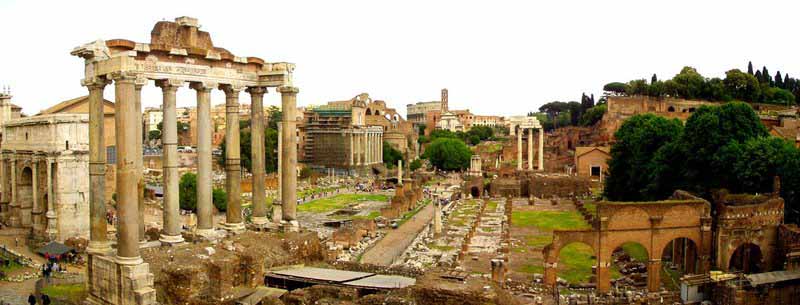




The Roman Forum (Forum Romanum, although the Romans referred to it more often as the Forum Magnum or just the Forum) was the central area around which ancient Rome developed, in which commerce, business, prostitution, cult and the administration of justice took place. Here the communal hearth was located. Sequences of remains of paving show that sediment eroded from the surrounding hills was already raising the level of the forum in early Republican times. Originally it had been marshy ground, which was drained by the Tarquins with the Cloaca Maxima. Its final travertine paving, still to be seen, dates from the reign of Augustus.
Excavation and preservation
An anonymous 8th century traveler from Einsiedeln (now in Switzerland) reported that the Forum was already falling apart in his time. During the Middle Ages, though the memory of the Forum Romanum persisted, its monuments were for the most part buried under debris, and its location was designated the "Campo Vaccino" or "cattle field," located between the Capitoline Hill and the Colosseum. The return of Pope Urban V from Avignon in 1367 led to an increased interest in ancient monuments, partly for their moral lesson and partly as a quarry for new buildings being undertaken in Rome after a long lapse. Artists from the late 15th century drew the ruins in the Forum, antiquaries copied inscriptions in the 16th century, and a tentative excavation was begun in the late 18th century.
A cardinal took measures to drain it again and built the Alessandrine neighborhood over it. But the excavation by Carlo Fea, who began clearing the debris from the Arch of Septimius Severus in 1803, and archaeologists under the Napoleonic regime marked the beginning of clearing the Forum, which was only fully excavated in the early 20th century.
Remains from several centuries are shown together, due to the Roman practice of building over earlier ruins. The ruins within the forum clearly show how urban spaces were utilized during the Roman Age. The Roman Forum includes a modern statue of Julius Caesar and the following major monuments, buildings, and ancient ruins.

The temple of Castor and Pollux in the Roman Forum was originally built in gratitude for victory at the battle of Lake Regillus (495 BC). Castor and Pollux (Greek Polydeuces) were the Dioscuri, the "twins" of Gemini, the twin sons of Zeus (Jupiter) and Leda. Their cult came to Rome from Greece via Magna Graecia and the Greek culture of Southern Italy.
The last king of Rome, Lucius Tarquinius Superbus, and his allies, the Latins, waged war on the infant Roman Republic. Before the battle, the Roman dictator Aulus Postumius Albinus vowed to build a temple to the Dioscuri if Rome was victorious.
According to legend Castor and Pollux appeared on the battlefield as two able horsemen in aid of the Romans. And, after the battle had been won they again appeared on the Forum in Rome watering their horses at the Spring of Juturna thereby announcing the victory. The temple stands on the supposed spot of their appearance. Postumius' son finished the temple in 484 BC.
In republican times the temple served as a meeting place for the Roman Senate, and from the middle of the 2nd century BC the front of the podium served as a speaker's platform. During the imperial period the temple housed the office for weights and measures, and was a depository for the State treasury.
The archaic temple was completely reconstructed and enlarged in 117 BC by Lucius Cecilius Metellus Dalmaticus after his victory over the Dalmatians. Gaius Verres again restored this second temple in 73 BC.
In 14 BC a fire that ravaged major parts of the forum destroyed the temple, and Tiberius, the son of Augustus by a previous marriage of Livia and the eventual heir to the throne, rebuilt it. Tiberius' temple was dedicated in 6 AD. The remains visible today are from the temple of Tiberius, except the podium, which is from the time of Metellus.
Architecture
The octostyle temple was peripteral, with eight Corinthian columns at the short sides and eleven on the long sides. There was a single cella paved with mosaics. The podium measures 32 x 49.5m and 7m in height. The building was constructed in opus caementicium and originally covered with slabs of tufa which were later removed. According to ancient sources the temple had a single central stairway to access the podium, but excavations have identified two side stairs.
A classical ruin
As many other buildings on the Forum Romanum, the temple has suffered destruction, looting and ruin over fifteen centuries. The temple was standing in the fourth century, but nothing is known of its subsequent history, except that in the fifteenth century only three columns were standing. The street running by them was called via Trium Columnarum. Today the podium survives without the facing, as do the three columns and a piece of the architrave, one of the most famous features in the Forum.
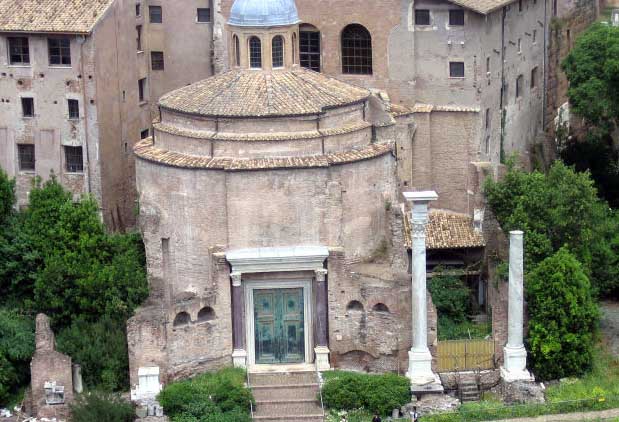
The basilica of Santi Cosma e Damiano is one of the ancient churches of Rome called tituli, of which cardinals are patrons as deacons: the Cardinal Deacon of the Titulus Ss. Cosmae et Damiani is Giovanni Cheli. The basilica, devoted to the two Greek brothers, doctors, martyrs and saints Cosmas and Damian, is located in the Forum of Vespasian, also known as the Forum of Peace.
The so-called Temple of Romulus was dedicated by Emperor Maxentius to his son Valerius Romulus, who died in 309 and was rendered divine honours. It is possible that the temple was in origin the temple of "Iovis Stator" or the one dedicated to Penates, and that Maxentius restored it before the re-dedication.
The ancient Roman fabric was Christianized and dedicated to Sancti Cosma et Damiano in 527, when Theodoric the Great, king of the Ostrogoths, and his daughter Amalasuntha donated the library of the Forum of Peace (Bibliotheca Pacis) and a portion of the Temple of Romulus to Pope Felix IV. The pope united the two buildings to create a basilica devoted to two Greek brothers and saints, Cosmas and Damian, in contrast with the ancient pagan cult of the two brothers Castor and Pollux, who had been worshipped in the nearby Temple of Castor and Pollux. The apse was decorated with a Roman-Byzantine mosaic, representing a parousia, the Second Coming of Christ at the end of time. The bodies of Saints Mark and Marcellian were translated, perhaps in the ninth century, to this church, where they were rediscovered in 1583 during the reign of Pope Gregory XIII.
In 1632, Pope Urban VIII ordered the restoration of the basilica. The works, projected by Orazio Torriani and directed by Luigi Arrigucci, raised the floor level seven metres, bringing it equal with the Campo Vaccino, thus avoiding the infiltration of water. Also, a cloister was added. The old floor of the basilica is still visible in the lower church, which is actually the lower part of the first church.
In 1947, the restorations of the Imperial Forums gave a new structure to the church. The old entrance, through the Temple of Romulus, was closed, and the temple restored to its original forms; with the Pantheon, the Temple of Romulus is the best preserved pagan temple in Rome. A new entrance was opened on the opposite side (on via dei Fori Imperiali), whose arch gives access to the cloister, and through this to the side of the basilica.

Next to the new entrance to the complex, there are the rooms with the original marble paving of the Forum of Peace, and the wall where the 150 marble slabs of the Forma Urbis Romae were hung. Through the cloister, the entrance to the church opens on the side of the single nave. The plan of the basilica followed the norms of the Counter-Reformation: a single nave, with three chapels per side, and the big apse, which now looks quite oversized because of the reduction in height of the 17th century restoration, framed by the triumphal arch, also mutilated by that restoration.
The importance of this Basilica for the history of medicine is not only related to the fact that the two brothers were physicians and became soon patrons of physicians, surgeons, pharmacists and veterinarians, but also to the tradition according to which Claudius Galen himself lectured in the Library of the Temple of Peace (Bibliotheca Pacis). Furthermore, for centuries, in this medical area roman physicians had their meetings.
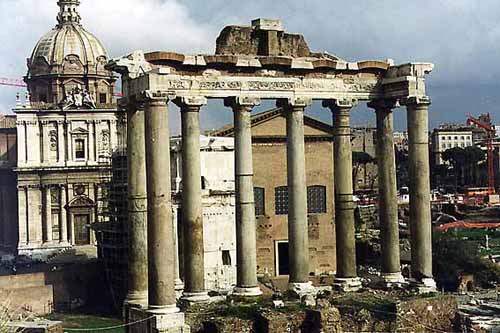
The Temple of Saturn (Latin: Templum Saturni or Aedes Saturnus) is a monument to the agricultural deity Saturn, that stands at the western end of the Forum Romanum in Rome. It represents the oldest-surviving foundation in that area, having been established between 501 and 498 BC. Some sources attributes it to the King Tarquinius Superbus, others to Lucius Furius, although the latter dedication could belong to a reconstruction after the fire set by the Gauls (early 4th century BC).
It was also called 'Aerarium', because the Roman national treasure was kept there. The temple marks the beginning of the Clivus Capitolinus, the old road that takes you up the hill of the Capitol.
The present ruins represent the third incarnation of the Temple of Saturn, replacing the second incarnation destroyed in the fire of 283.
According to the sources, the statue of the god in the interior, veiled and provided with a scythe, was wooden and filled with oil. The legs were covered with linen bents, which were released only on December 17, the day of the Saturnalia. While dedicated to the god Saturn, the temple's chief use was as the seat of the treasury of the Roman Empire (aerarium), storing the Empire's reserves of gold and silver. Also the state archives, the insignia and the official scale for the weighing of metals were housed in the temple. Later, the aerarium was moved to an apposite edifice, while the archives were transferred to the nearby Tabularium. The temple's podium, in concrete covered with travertine, was used for bill-posting.
Gradual collapse has left nothing but the remains of the front portico standing, but the eight surviving columns and partially intact pediment (displaying the inscription Senatus Populusque Romanus incendio consumptum restituit, meaning "The Senate and People of Rome restored what fire had consumed") represent one of the iconic images of Rome's ancient architectural heritage.

The Temple of Vesta (Latin: Aedes Vestae) in the Roman Forum stands between the Temple of Castor and Pollux, the Temple of Caesar, the Regia and the House of the Vestal Virgins. The temple has a number of significant architectural features. It was modeled after the first Roman houses which were round huts made of mud and straw. Since the worship of Vesta began in private homes, the architecture seems to be a reminder of its history. The temple used Greek architecture with Corinthian columns, marble, and a central cella. The internal cella was surrounded by twenty Corinthian columns built on a podium fifteen meters in diameter. The roof had a vent, which made tending Vesta's sacred flame a demanding task. Another round outer wall went along the entire outside with more columns.
All temples to Vesta were round, and had entrances facing east to symbolise connection between Vesta’s fire and the sun as sources of life. The Temple of Vesta in the Forum Romanum was built in the 3rd century B.C. It is not truly a temple because it was never inaugurated, nor does it hold a statue of Vesta, but only her sacred flame and the Palladium. The Palladium was a statue of Athena (Roman Minerva) believed to have been brought by Aeneas from Troy. According to Dionysius of Halicarnassus, the Romans believed that the Sacred fire of Vesta was closely tied to the fortunes of the city and viewed its extinction as a portent of disaster.
Since there was fire enclosed in the temple, there was risk of burning. The Temple of Vesta did burn twice in its history. In AD 64 a huge fire during the rule of the infamous Nero burned most of Rome, including the Temple of Vesta. After a fire in 191, Julia Domna, the wife of Septimius Severus, had the temple restored. Unfortunately, since that time, the temple has been looted and was stripped of its marble during the 16th century. The section standing today was reconstructed in the 1930s.

The Temple of Venus and Roma (Latin: Templum Veneris et Romae) was the largest known temple in Ancient Rome. Located at the far east side of the Forum Romanum near the Colosseum, it was dedicated to the goddesses Venus Felix (Venus the Bringer of Good Fortune) and Roma Aeterna (Eternal Rome). The architect was the emperor Hadrian. Construction of the temple began in 121. It was officially inaugurated by Hadrian in 135, and finished in 141 under Antoninus Pius. Damaged by fire in 307, it was restored with alterations by the emperor Maxentius.
Set on a stylobate measuring 145 metres (476 ft) in length and 100 metres (328 ft) in width, and stood 29.5 metres (97 ft) tall, being 31 metres (102 ft) counting the statues, the peristyle (also peripteral) building measured 110 metres (361 ft) in length and 53 metres (174 ft) in width. The temple itself consisted of two main chambers (cellae), each housing a cult statue of a Venus, the goddess of love, and Roma, the goddess of Rome, both figures seated on a throne. The cellae were arranged symmetrically back-to-back.
Roma's cella faced west, looking out over the Forum Romanum, and Venus' cella faced east, looking out over the Colosseum. A row of four columns (tetrastyle) lined the entrance to each cella, and the temple was bordered by colonnaded entrances ending in staircases that led down to the Colosseum.
The west and east sides of the temple (the short sides) had ten white columns (decastyle), and the south and north (the long sides) featured eighteen white columns. All of these columns measured 1.8 metres (6 ft) in width, making the temple very imposing.
A reconstruction of the temple interior by German Architect Josef Bühlmann from 1913 depicts two longitudinal colonnades of Corinthian columns forming a central nave flanked by two aisles below a coffered vaulted ceiling. Resting on the columns a double impost forms a double entablature extending back into the exedra, with a cofferred half-dome ceiling above the seated statue. The walls behind the aisles are inset with smaller columns standing some distance above the floor on a plinth. Small statues set in niches between these columns punctuate the walls, the niches surmounted by alternating arched and triangular pediments. More small statues are positioned on the entablature above each small column.
As an additional clever subtlety by Hadrian, Venus also represented love (Amor in Latin), and "AMOR" is "ROMA" spelled backwards. Thus, placing the two divinities of Venus and Rome back-to-back in a single temple created a further symmetry with the back-to-back symmetry of their names as well. Within Venus' cella was another altar where newly wed couples could make sacrifices. Directly adjacent to this altar stood gigantic silver statues of Marcus Aurelius and Faustina the Younger.
In order to build the temple, erected on the remains of Nero's Domus Aurea, the Colossus of Nero was moved and placed near the amphitheatre, which shortly afterwards became known as the Colosseum. Unimpressed by his emperor's architectural skills, Hadrian's most brilliant architect, Apollodorus, made a scornful remark on the size of the seated statues within the cellae, saying that they would surely hurt their heads if they tried to stand up from their thrones. Apollodorus was banished and executed not long after this.
Major damage to the temple caused by a fire in 307 was restored by the emperor Maxentius. The restoration altered Hadrian's original design, adding the semi-circular niches (exedrae) in the rear of each cella for the cult statues. The present-day remains are of this temple.
Further restoration was performed under Eugenius, a short-lived usurper (392-394) against Theodosius I, whose policy was the restoration of Pagan cults and temples.
A severe earthquake at the beginning of the 9th century unfortunately destroyed the temple once again. Around 850 Pope Leo IV ordered the building of a new church, Santa Maria Nova, on the ruins of the temple. After a major rebuilding in 1612, this church was renamed Santa Francesca Romana, incorporating Roma's cella as the belltower.
Over the centuries most of the columns surrounding the temple disappeared. Presently only a few remain standing in their original positions, while others that have gone missing have been replaced by buxus trees.
The fashion designer Valentino Garavani contributed 200,000 euro towards the Temple's restoration in return for a 600-seat private banquet he held there in June 2007 to commemorate his 45th anniversary in haute couture.
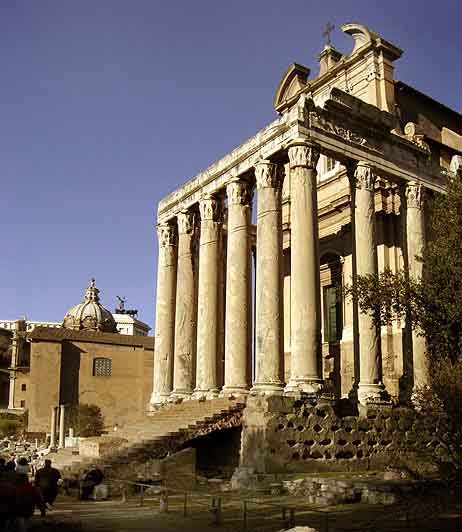
The Temple of Antoninus and Faustina is an ancient Roman temple in Rome, adapted to the church of San Lorenzo in Miranda. It lies in the Forum Romanum, on the Via Sacra, opposite the Regia. The temple was begun in 141 by the Emperor Antoninus Pius, and was intitially dedicated to his deceased and deified wife, Faustina the Elder. When Antoninus Pius was deified, after his death in 161, at the instigation of his successor, Marcus Aurelius, the temple was re-dedicated jointly to Antoninus and Faustina.
The building stands on a high platform of large peperino blocks. The later of two dedicatory inscriptions says, "Divi Antonino et Divae Faustinae Ex S.C." meaning, “To the divine Antoninus and to the divine Faustina by decree of the Senate.” The ten monolithic Corinthian columns of its pronaos are 17 m. tall. The rich bas-reliefs of the cornice, of garlanded griffons and candelabri, was often copied from the sixteenth through the nineteenth centuries.
The temple was converted to a church, known as San Lorenzo in Miranda, perhaps as early as the seventh century, but it is only attested from the eleventh century Mirabilia Urbis Romae. "Miranda" may derive from the name of a benefactress. It was then thought that this was where St Lawrence had been sentenced to death.
The deep grooves in the temple's pillars are said to date to a medieval attempt to dismantle the pillared portico, either for spolia or to destroy what was then still seen as a pagan temple. Also in the Middle Ages, a staircase was built on the Forum side, but it is now impossible to enter from that side as there is a gap of about six metres between the top of the stairs and the door, since the Forum had not yet been dug out and thus its ground level was far higher than it now is. Excavations in front of the temple were undertaken in 1546 again in 1810, and at internals from 1876.

The Temple of Caesar (Aedes Divus Iulius or Templum Divi Iulii) was begun by Augustus in 42 BC after the senate deified Julius Caesar posthumously. Augustus dedicated the Ionic prostyle temple to Caesar (his adoptive father) on August 18, 29 BC, after the Battle of Actium. It stands on the east side of the main square of the Roman Forum (Forum), between the Regia, Temple of Castor and Pollux and the Basilica Aemilia, on the site of Caesar's cremation (Caesar's testament was read at the funeral by Marcus Antonius).
Caesar was the first resident of Rome (after Romulus) to be deified and so honored with a temple. (The Temple of Romulus presently in existence near the Temple of Antoninus and Faustina is dedicated not to the founder of Rome, but to a deified son of the emperor Maxentius). A fourth flamen maior was dedicated to him after 44 BC and Marcus Antonius was appointed as his flamen. It was with the Temple of Caesar that Augustus started the transition from private worship to public worship.
The high platform on which the temple was built served as a rostra (Rostra Juli) and, like the Rostra at the opposite end of the Forum, was decorated with the beaks of ships taken at the battle of Actium. In the frontal side of the platform there is a recessed semicircular niche and an altar that marked the site of the funeral pyre of Caesar. This strange detail, absolutely unique in the Roman architecture, was probably a result of the very narrow space then available on the Forum. Even so, this temple's construction excluded the ancient Regia and the Temple of Vesta from the main square of the Forum.
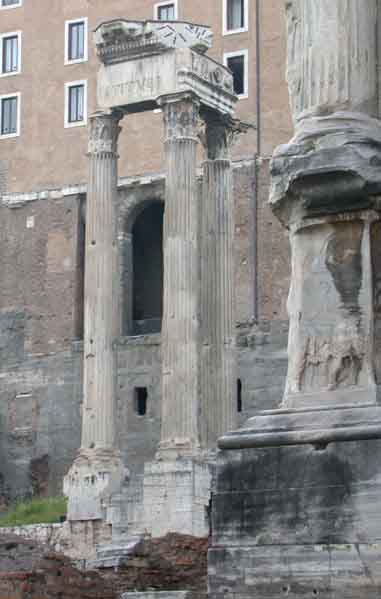
The Temple of Vespasian and Titus (Latin - templum divi Vespasiani) is located in Rome at the western end of the Roman Forum between the Temple of Concordia and the Temple of Saturn. It is dedicated to the deified Vespasian and his son, the deified Titus. It was begun by Titus in 80 A.D. after Vespasian's death and Titus's succession. Titus’ brother, Domitian, completed and dedicated the temple to Titus and Vespasian in approximately 87 A.D.
Throughout Roman history, there was an emphasis on increasing the fame and glory of a family name, often through monuments commemorating the deceased. Therefore, the temple was constructed to honor the Flavian Dynasty, which comprised the emperors Vespasian (69-79), Titus (79-81), and Domitian (81-96). Historians question whether or not Titus and Domitian had a good relationship; however, Domitian ensured the deification of his brother into the imperial cult in order to exalt the prominence of the Flavian name. Titus and Vespasian were each deified through the ceremony of apotheosis. In doing so, tradition guaranteed that Roman citizens and subjects would honor Vespasian and Titus (or at least honor their genius) as Roman deities. This imperial cult worship was as much a sign of allegiance to the emperor of Rome, or as a political and diplomatic gesture, as it was a formal religion.
The Temple of Vespasian was in the Corinthian order, hexastyle (ie with a portico six columns wide), and prostyle (ie with free standing columns that are widely spaced apart in a row). It was particularly narrow due to the limited space, measuring 22 meters long and 22 wide. In a constricted space between this temple and the Concord, a small, two story vaulted room made of brick and concrete, and lined with marble, was built against the wall of the Tabularium, and apparently was dedicated to Titus.
Titus began construction and presumably finished the foundations, made of tufa concrete, and the core of the podium, made of white marble. Domitian, however, completed the interior work after Titus’ death. The cella (inner) walls were in travertine, lined with marbles imported at great expense from the eastern provinces. The interior is highly ornate and the frieze depicts sacred objects that would have been used as the symbols, or badges, of the various priestly collegia in Rome. Around 200 to 205 A.D., Emperors Septimius Severus and his son, Caracalla, conducted renovations on the temple.
The temple suffered significant damage during mediaeval times, particularly c. 1300 (under Pope Boniface VIII), and in Pope Nicholas V's remodelling of the Forum (which involved the demolition of both angles of the temple on the Forum side and the reconstruction of its front as a fortress with corner towers). All that survives today is the podium's core (with some of its peperino lining), parts of the cella (two fragments of its travertine wall and part of the pedestal at its back for the cult statues), and three Corinthian columns at pronaos's south-east corner.
The temple suffered significant damage during mediaeval times, particularly c. 1300 (under Pope Boniface VIII), and in Pope Nicholas V's remodelling of the Forum (which involved the demolition of both angles of the temple on the Forum side and the reconstruction of its front as a fortress with corner towers). All that survives today is the podium's core (with some of its peperino lining), parts of the cella (two fragments of its travertine wall and part of the pedestal at its back for the cult statues), and three Corinthian columns at pronaos's south-east corner.
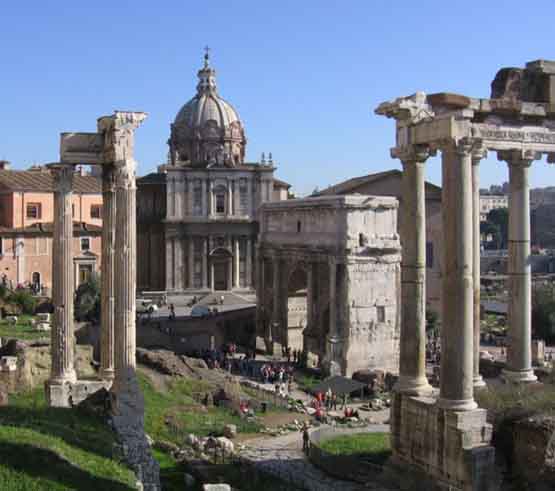
The Temple of Concord was the main temple in the ancient city of Rome dedicated to the goddess Concordia. It was situated at the western end of the Roman Forum, Rome.
Roman literature states that it was first vowed by Marcus Furius Camillus in 367 BC to commemorate the Leges Liciniae Sextiae of Lucius Sextius Lateranus and the resulting reconciliation between the patricians and plebians after the Aventine Secession. This early foundation date is strongly disputed, however.[citation needed] It was a frequent focus for fostering harmony in the Roman state, both through its first rebuilt in 121 BC (after the murder of Tiberius Gracchus), and through its occasional use for meetings of the Senate, especially in times of civil disturbance (Cicero delivered his fourth Catilinarian oration here).
It was again restored between 7 and 10 AD by Tiberius as Augustus's heir, better to use the limited available area on the site. He probably rededicated it in AD 12. This restoration was distinguished by its opulent marble and rich architectural ornamentation, and Tiberius's housing of numerous Greek paintings, sculpture and other works of art there (listed in Pliny's Natural History), making it something akin to an art museum.
Backed up against the Tabularium at the foot of the Capitoline Hill, the architecture had to accommodate the limitations of the site. The cella of the temple, for instance, is almost twice as wide (45m) as it is deep (24m), as is the pronaos. In the cella a row of Corinthian columns rose from a continuous plinth projecting from the wall, which divided the cella into bays, each containing a niche. The capitals of these columns had pairs of leaping rams in place of the corner volutes. Only the platform now remains, partially covered by a road up to the Capitol.
The main temple in the Forum in Rome seems to have been a model for temples to the goddess elsewhere in the empire - a reproduction of this temple was found in Mérida (Spain), during the excavations of the town's forum in 2002.
The Shrine of Venus Cloacina was a small sanctuary on the Roman Forum, in front of the Basilica Aemilia. The shrine was dedicated to Venus as the deity of Cloaca Maxima, the main sewer of ancient Rome. Venus was identified with the goddess of Cloacina who had Etruscan origins. The shrine was also the entrance of the sewage system.
The origin of the shrine of Venus Cloacina dates back to the founding of Rome and the rape of the Sabine women. According to Pliny the Elder, when the Romans and the Sabines decided to make peace both the Romans and the Sabines laid down their weapons at the location of the shrine and purified themselves with sprigs of myrtle.
The shrine was built on the Via Sacra near the area of the Tabernae Novae, which was later removed to make room for the Basilica Aemilia. The shrine was believed to be an entrance way to the Cloaca Maxima, but only the foundations of the original shrine currently remain. Historians have a basic idea what the shrine looked like because coins were minted during the second triumvirate with an image of the Shrine of Venus Cloacina on one side. The coins show a small round structure with a metal balustrade.

The Via Sacra or Sacred Way was the earliest street through the forum. In the fifth century B.C., the road was supported by a substructure to protect it from the rain. Later it was paved and during the reign of Nero it was lined with colonnades. In the background is the Arch of Titus.
The Via Sacra (Latin: Sacred Road) is the main street of ancient Rome, leading from the top of the Capitoline Hill, through some of the most important religious sites of the Forum (where it is the widest street), to the Colosseum. This road was continually filled with solemn religious festivals, magnificent triumphs of victorious generals, and the daily throng assembling in the basilicas to chat, throw dice, engage in business, or secure justice.
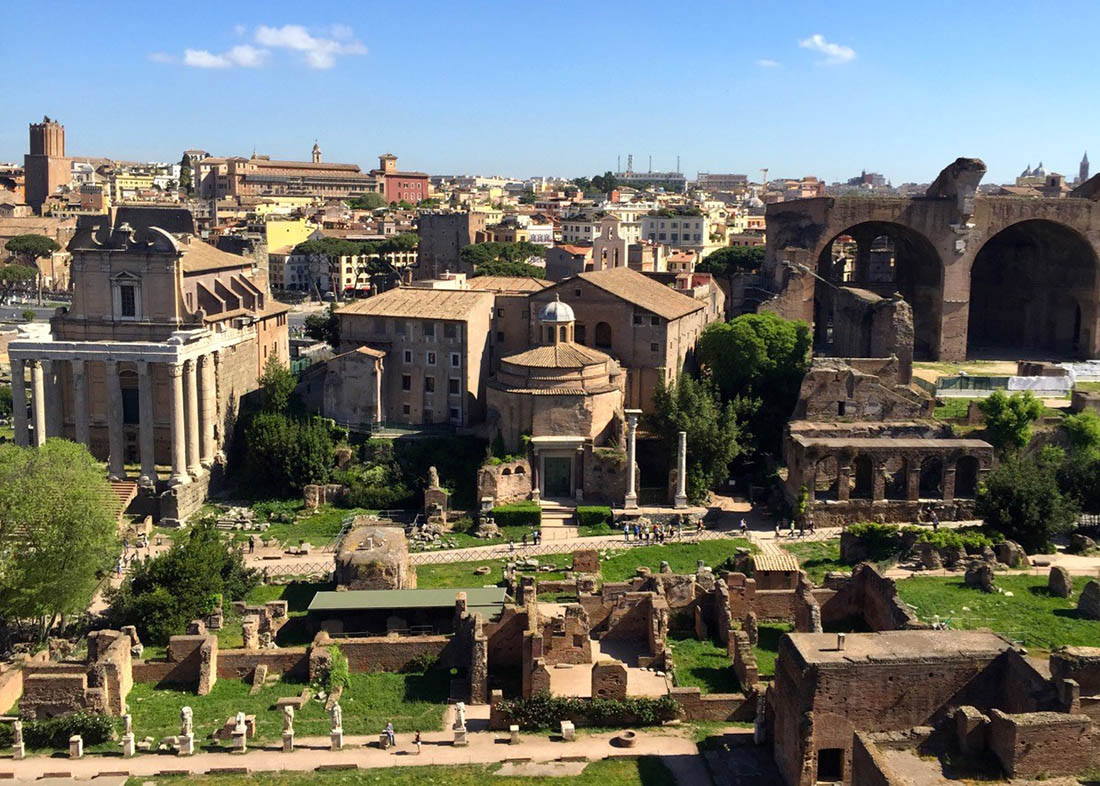
The Palattino, the Palatine Hill, Rome, Italy
The Palatine Hill (Latin: Collis Palatium or Mons Palatinus) is the centermost of the Seven Hills of Rome and is one of the most ancient parts of the city. It stands 40 metres above the Forum Romanum, looking down upon it on one side, and upon the Circus Maximus on the other. It is the etymological origin of the word "palace" and its cognates in other languages (Italian "Palazzo", French "Palais" etc).
According to Roman mythology, the Palatine Hill was the location of the cave, known as the Lupercal, where Romulus and Remus were found by the she-wolf that kept them alive. According to this legend, the shepherd Faustulus found the infants, and with his wife Acca Larentia raised the children. When they were older, the boys' killed their great-uncle (who seized the throne from their father), and they both decided to build a new city of their own on the banks of the River Tiber. Suddenly, they had a violent argument with each other and then in the end Romulus killed his twin brother Remus. This is how "Rome" got its name - from Romulus. Another legend to occur on the Palatine is Hercules' defeat of Cacus after the monster had stolen some cattle. Hercules struck Cacus with his characteristic club so hard that it formed a cleft on the southeast corner of the hill, where later a staircase bearing the name of Cacus was constructed.
Rome has its origins on the Palatine. Indeed, recent excavations show that people have lived there since approximately 1000 BC. Many affluent Romans of the Republican period (510 BC - c. 44 BC) had their residences there. The ruins of the palaces of Augustus (63 BC - 14), Tiberius (42 BC - 37) and Domitian (51 - 96) can still be seen. Augustus also built a temple to Apollo here, beside his house. The Palatine Hill was also the site of the festival of the Lupercalia.
One building, believed to be the residence of Livia (58 BC – 29), the wife of Augustus, is currently undergoing renovation. Situated near to the house of Livia is the temple of Cybele, currently not fully excavated and not open to the public. Behind this structure, cut into the side of the hill, is the so-called House of Tiberius.
Overlooking the Forum Romanum is the Flavian Palace which was built largely during the reign of the Flavian dynasty (69 – 96) – Vespasian, Titus and Domitian. This palace, which was extended and modified by several emperors, extends across the Palatine Hill and looks out over the Circus Maximus. The building of the greater part the palace visible from the Circus was undertaken in the reign of the emperor Septimius Severus (146 – 211).
Immediately adjacent to the palace of Severus is the Hippodrome of Domitian. This is a structure which has the appearance of a Roman Circus and whose name means Circus in Greek, but is too small to accommodate chariots. It can be better described as a Greek Stadium, that is, a venue for foot races. However, its exact purpose is disputed. While it is certain that during the Severan period it was used for sporting events, it was most likely originally built as a garden shaped like a stadium. According to a guide from the Sopraintendenza Archeologica di Roma, most of the statuary in the nearby Palatine museum comes from the Hippodrome. (Domitian also built a larger stadium that was actually used for foot-racing competitions; it exists today as Piazza Navona, lo stadio di Domiziano.)
The Palatine Hill is now a large open-air museum and can be visited during the daytime for a small charge on the same ticket as the Colosseum. There are two entrances, one near the Arch of Titus on the Forum Romanum and the other on Via di San Gregorio, the street just beyond the Arch of Constantine, going away from the Colosseum.
During Augustus' reign, an area of the Palatine Hill was roped off for a sort of archaeological expedition, which found fragments of Bronze Age pots and tools. He declared this site the "original town of Rome." Modern archaeology has identified evidence of Bronze Age settlement in the area which predates Rome's founding. There is a museum on the Palatine in which artifacts dating from before the official foundation of the City are displayed. The museum also contains Roman statuary.
An altar to an unknown deity, once thought to be Aius Locutius, was discovered here in 1820. In July 2006, archaeologists announced the discovery of the Palatine House, which they believe to be the birthplace of Rome's first Emperor, Augustus. Head archaeologist Clementina Panella uncovered a section of corridor and other fragments under Rome's Palatine Hill, which she described on July 20 as "a very ancient aristocratic house." The two story house appears to have been built around an atrium, with frescoed walls and mosaic flooring, and is situated on the slope of the Palatine that overlooks the Colosseum and the Arch of Constantine. The Republican-era houses on the Palatine were overbuilt by later palaces after the Great Fire of Rome (64), but apparently this one was not; the tempting early inference is that it was preserved for a specific and important reason. On the ground floor, three shops opened onto the Via Sacra.
The location of the domus is important because of its potential proximity to the Curiae Veteres, the earliest shrine of the curies of Rome. In January 2007 Italian archeologist Irene Iacopi announced that she had probably found the legendary Lupercal cave beneath the remains of Augustus' residence, the Domus Livia (House of Livia) on the Palatine. Archaeologists came across the 16-metre-deep cavity while working to restore the decaying palace. The first photos of the cave show a richly decorated vault encrusted with mosaics and seashells. The Lupercal was probably converted to a sanctuary by Romans in later centuries.
On November 20 2007 archaeologists unveiled photographs of the cave. Partially collapsed and decorated with seashells and colored marble, the vaulted sanctuary is buried 16 metres inside the Palatine hill. A white eagle was found atop the sanctuary's vault.
Most of the sanctuary is collapsed or filled with earth, but laser scans allowed experts to estimate that the circular structure has a height of 8 metres and a diameter of 7.3 metres.